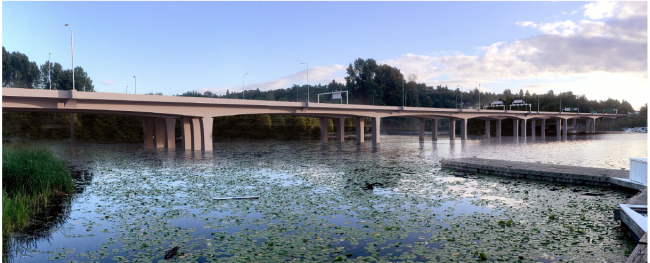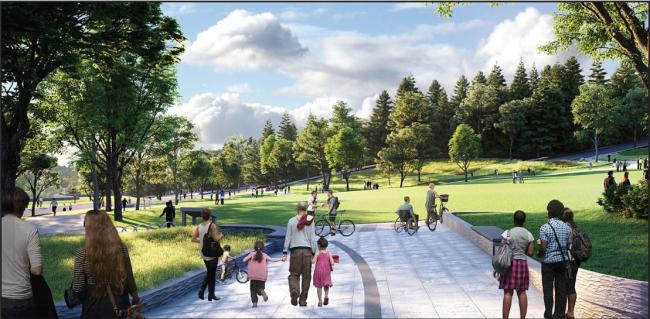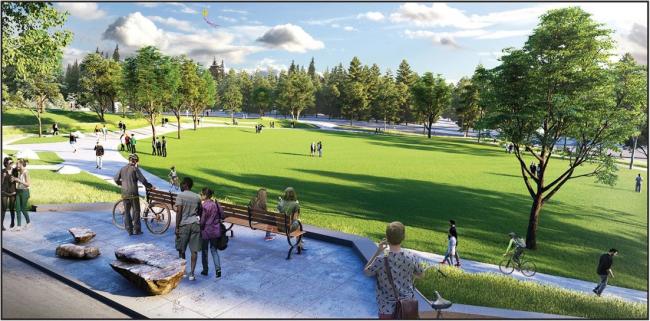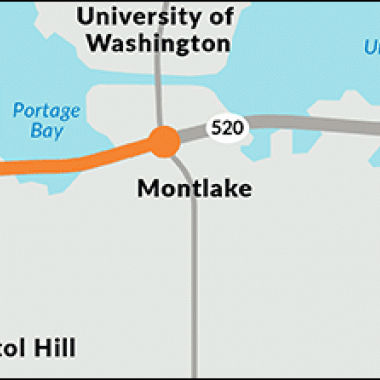Project overview
The Portage Bay Bridge and Roanoke Lid Project will replace the aging Portage Bay Bridge with a seismically resilient structure that includes improved bus/carpool travel and an extension of the SR 520 Trail. This project also builds a landscaped lid between Seattle’s Roanoke Park and North Capitol Hill neighborhoods.
What to expect
Please visit SR520Construction.com for updates on traffic and information about the beaver lodge, tree removals and construction staging.
This project will complete SR 520’s reconstruction between Bellevue and Seattle.
Plans and process
The 1960s-era Portage Bay Bridge is nearing the end of its functional life. Supported by hollow concrete columns, the four-lane bridge could collapse in a severe earthquake. This project will replace the old bridge with seismically stronger structures. The project also includes a new lid covering the highway with approximately three acres of neighborhood open space and new local and regional non-motorized trails.
The Portage Bay Bridge and Roanoke Lid Project is part of the SR 520 Bridge Replacement and HOV Program. It’s a key piece of the “Rest of the West” — the final improvements to the SR 520 corridor in Seattle. The four “Rest of the West” projects were included in the SR 520 Program’s Final Environmental Impact Statement. They were further refined through community engagement processes that brought together local government partners, design professionals and community members.
These processes influenced the project’s current design concept, such as identifying the preferred structure type for new, parallel Portage Bay bridges. The community also helped further refine the design of a new Roanoke lid and bicycle and pedestrian amenities within the project area. You can read about these design refinement processes on the SR 520 Program Community Engagement tab.
This project is a central part of the larger, ongoing megaprogram that is reconstructing the SR 520 corridor from I-405 in Bellevue to I-5 in Seattle. We’ve completed several phases of the larger SR 520 Bridge Replacement and HOV Program, including:
- Floating Bridge and Landings Project: Building the world’s longest floating bridge on Lake Washington between Seattle and the Eastside, and constructing the bridge’s 44 smaller pontoons in Tacoma.
- Pontoon Construction Project: Constructing the floating bridge’s 33 largest pontoons in Aberdeen, Washington.
- Eastside Transit and HOV Project: Rebuilding the highway’s Eastside segment between I-405 and Lake Washington’s east shore.
- West Approach Bridge North Project: Completing the first of two parallel west approach bridges over Union Bay, between the floating bridge and Seattle’s Montlake neighborhood.
The Montlake Project, currently under construction, is completing the second of two parallel west approach bridges over Union Bay. This project includes a new landscaped lid between Montlake Boulevard and 24th Avenue East. It also includes a bicycle and pedestrian land bridge east of the lid.
When the corridor’s reconstruction is fully completed in the late 2020s:
- All of SR 520’s major bridges will be replaced with seismically stronger structures.
- Bus/carpool lanes and a regional bicycle/pedestrian path will extend between Seattle and Redmond. Travelers will have access to new ramps and improved connections to transit, local streets, and local and regional shared-use trails.
Project benefits
- Safer travel from replacement of the old, structurally vulnerable Portage Bay Bridge with two parallel, seismically stronger bridges
- Improved regional mobility with completion of the SR 520 Program’s transit & HOV enhancements between Redmond and Seattle
- Greater transportation options through an extension of the regional SR 520 Trail across Portage Bay, a new bicycle and pedestrian crossing over I-5, and connections to the city of Seattle’s non-motorized trail networks
- A community-connecting highway lid between 10th Avenue East and Delmar Drive East, with landscaped open space on top
- Improved water quality from a new system for treating SR 520 stormwater runoff
- Wider highway shoulders that allow disabled vehicles to pull over without blocking traffic
Project design
The SR 520 Program’s community engagement webpage contains extensive information about the design development process for the SR 520 Program. Some of those processes focused on the design of the Portage Bay Bridge and Roanoke Lid Project elements, including:
- 2011-2012 Seattle Community Design Process: WSDOT worked with Seattle officials, design professionals and the public to refine the conceptual design for SR 520 in Seattle. This process included seven public workshops, thousands of public comments, and extensive coordination with the public and key partner agencies. After this, WSDOT published a Seattle Community Design Process final report (PDF 31MB). This report summarizes design refinements incorporated into the SR 520 conceptual design.
- 2014-2015 West Side Design Refinements: Following a legislative directive, WSDOT continued working with the city of Seattle and design professionals. Together, they recommended further analysis of elements that weren’t resolved in the 2012 process. This led to several design refinements, such as a recommended bridge type for the Portage Bay Bridge. Another refinement was the addition of a bicycle and walking path on the future Portage Bay Bridge. This work is summarized in the West Side Design Refinements final report (PDF 61.9B).
- 2019 Community Stakeholder Workshops: WSDOT hosted a six-month public outreach process. Through this, WSDOT got public feedback on refining conceptual design elements for the Portage Bay Bridge and Roanoke Lid Project. The outreach included open houses, three design workshops and coordination with the city of Seattle and Seattle Design Commission. A Community and Stakeholder Outreach report (PDF 4.2MB) summarizes the outreach and the public’s design ideas for key project elements. The report includes how WSDOT incorporated those ideas into a refined design concept and the verbatim comments from the community.
Environmental plans
In September 2020, we hosted a two-week online open house and a virtual public meeting to gather public feedback on three key environmental processes for the Portage Bay project. This summary of public feedback (PDF 476 KB) provides an overview of the three processes and the major comment themes we received from the community. The report also includes a Q&A with WSDOT responses to the major public comments and questions, along with the verbatim comments submitted during the online open house. More information about the SR 520 Program’s environmental studies can be found on the SR 520 Program Environmental tab.
This project is part of the $2.69 billion in SR 520 Seattle Corridor Improvements – west end. These improvements are funded by the 2015 Connecting Washington and 2022 Move Ahead Washington transportation legislation packages.
Rendering of a future SR 520 bridge stretching across Portage Bay.

Plan view of the future Roanoke Lid, looking southeast.

Plan view from the future Federal Avenue East overlook, looking northeast across the future Roanoke Lid

Monthly Portage Bay Project construction update meeting
Registration for our July monthly meeting coming soon. Missed our June monthly meeting? You can view the presentation online (PDF 7.7MB) or view the meeting recording on YouTube.
Here are some resources you can use to stay informed about this project:
- View construction progress on our camera feeds.
- Read more about what to expect for this project on our SR 520 Construction Corner Future Construction Projects page.
- Check the SR 520 Construction Corner Map for the latest information on construction activity and planned highway closures.
- For more information about how we manage construction effects, visit the SR 520 Construction Corner Managing Construction Effects page.
- Twitter: @wsdot_520
- SR 520 Flickr collection
- SR 520 Program home page
Project Team
SR 520 Program information line: 206-200-9484 (M-F, 8 to 5)
24-hour construction hotline: 206-319-4520
sr520bridge@wsdot.wa.gov
If your organization is interested in receiving a project briefing or presentation, please contact us.

